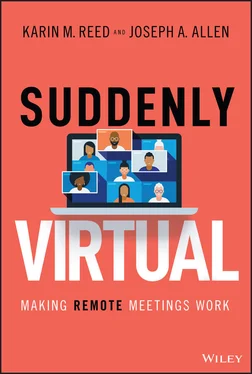Big events such as these flashbulb moments or lengthy world events (e.g. World War I, World War II, etc.) usually mean big changes. And these big changes usually have a lasting effect. For example, following the events of September 11, 2001, in the United States, the experience of getting on a plane in the U.S. changed forever with long lines for screening passengers, waiting areas forbidden for all but those who held tickets, and shoes removed while screening, among other things. Changes like these sometimes last in the name of safety, while others may remain out of convenience or cost savings. If you are in commercial real estate, consider this your warning. Remote work and the virtual office are big changes caused by a big event that will not be going away.
Work changed for many. With the noted exceptions of many essential workers, the so‐called “knowledge workers” were required to work differently. Instead of commutes and coffee at the corner shop, many began to roll out of bed, dress for success on the top half, make some passable coffee in a home brewing machine, and flip the laptop open for a long day of work from home. We would write our reports, crunch our numbers, take out the garbage, answer some email, fix our child's phone, deal with some urgent texts from a colleague, walk the dog, and log out an hour or two later than we did when we worked in the office. In fact, the average U.S. worker increased their hours worked per day by as much as three hours (Davis and Green 2020).
In this new work‐from‐home environment, we found ourselves no longer meeting with our colleagues face‐to‐face. The face‐to‐face meeting was banished and essentially vanished. Our video cameras came on, our cats started making cameos in our meetings, our children were now understood interruptions, and our pants became optional (hopefully unbeknownst to our colleagues). And with all of these elements of our new normal . . . the rise of the virtual meeting.
What Happened to Meetings?
Just prior to the pandemic in October 2019, Joe had the fortunate chance to collect data concerning virtual meetings with his colleagues at the University of Nebraska at Omaha. Although the data was limited to U.S. workers, its meaning increased dramatically as 2020 unfolded. In October 2019, nearly 80% of meetings were face‐to‐face, with less than 4% held over video. A little more than 13% of meetings were classified as hybrid, which refers to meetings where a couple of people may be in one conference room talking to folks in another conference room in another city, or country, via telephone or video conference. Thus, the vast majority of us essentially met face‐to‐face, be it in our office, our conference rooms, at our favorite coffee shops, restaurants, or even bars. As the bar graph below shows, things changed both dramatically and quickly.

After the onset of the pandemic, meetings became suddenly virtual. Workers experienced a 60% jump of meetings on video – almost 20 times the rate from before COVID‐19. Telephone meetings jumped to nearly 25% of our meetings while face‐to‐face meetings were one‐seventh its former total. In other words, we stopped meeting face‐to‐face, except in certain occupations deemed essential such as medical doctors, nurses, and other healthcare providers. However, even healthcare saw a rapid rise in telehealth. According to a survey by Sermo, an online physician network, 85% of physicians had adopted telehealth (typically video visits with patients), and 60% said they planned to continue using telehealth even after the pandemic is in the past (Wicklund 2020).
Unsurprisingly, videoconferencing software boomed. Total video calls in Microsoft Teams experienced 1000% growth in March 2020 alone (Spataro 2020). Zoom, Webex, Google groups, BlueJeans, Skype, and other software saw similar or even greater growth during that same time. The default camera in many people's laptops went from being covered with tape for “privacy” to being a window into our homes and the homes of our colleagues, as videoconferencing became the main way for us to meet and collaborate during a pandemic.
Large meetings and conferences shifted to virtual as well, sometimes with lightning‐fast response times. Artificial Intelligence (AI) company Nuance took its global research and development (R&D) conference online in a matter of days using a Microsoft Teams channel and a PDF agenda with links to session events. Hundreds of attendees were able to benefit from the wealth of cutting‐edge information shared through a conference that cost Nuance almost nothing to put on. The previous year's event cost Nuance approximately $700,000 (Spataro 2020). CompTIA, a nonprofit trade association in the IT industry, made the pivot to all virtual. Ten days prior to a long‐planned, in‐person conference in Chicago, they decided to flip the switch and take it all online. The painstakingly prepared agenda, chock‐full of working group meetings, speakers, sessions, and even a St. Patrick's Day celebration along the dyed‐green Chicago River, was reworked for the new platform. And it worked – the virtual event attracted five times more people than were expected to attend the Chicago event, and CompTIA called the industry response to the conference “overwhelmingly positive” (Campbell 2020). The trend continued for months to come. Joe's professional conference, the Society for Industrial and Organizational Psychology (SIOP) conference, was online in June 2020, and the Interdisciplinary Network for Group Researchers (INGRoup) was online in October 2020.
Given our observations and the trends just identified, how we meet on a regular basis has changed, perhaps for good. Sure, COVID‐19 will not last forever, but the tools used to collaborate during this time will continue to be available and a viable option for working remotely, working from home, and so on. Thus, in the following chapter, we acknowledge the truth: videoconferencing is a viable alternative for face‐to‐face meetings – and it works.
The pandemic changed how many people work and how many people meet to collaborate and accomplish their jobs.
The format for meetings switched from face‐to‐face being the dominant form to the virtual meeting, primarily video‐based interaction.
The short‐term move to remote meetings will likely be part of a long‐term impact – the way we meet will never be the same.
1 Campbell, Scott. 2020. “Canceled by COVID‐19? Here's how to pivot your in‐person meeting into a virtual success.” CompTIA (blog). https://www.comptia.org/blog/how-in-person-virtual-event#.Xo9TPaSjnGA.linkedin.
2 Davis, Michelle F., and Jeff Green. 2020. “Three hours longer, the pandemic workday has obliterated work‐life balance.” Bloomberg. https://www.bloomberg.com/news/articles/2020-04-23/working-from-home-in-covid-era-means-three-more-hours-on-the-job.
3 Kantis, Caroline, Samantha Kiernan, and Jason Socrates Bardi. 2020. “UPDATED: Timeline of the Coronavirus.” Think Global Health. Council on Foregin Relations. https://www.thinkglobalhealth.org/article/updated-timeline-coronavirus.
4 Spataro, Jared. 2020. “Remote work trend report: Meetings.” Microsoft 365 (blog). https://www.microsoft.com/en-us/microsoft-365/blog/2020/04/09/remote-work-trend-report-meetings/.
5 Wicklund, Eric. 2020. “COVID‐19 gives providers a blueprint for new telehealth strategies.” mHealth Intellegence. https://mhealthintelligence.com/features/covid-19-gives-providers-a-blueprint-for-new-telehealth-strategies.
Читать дальше













